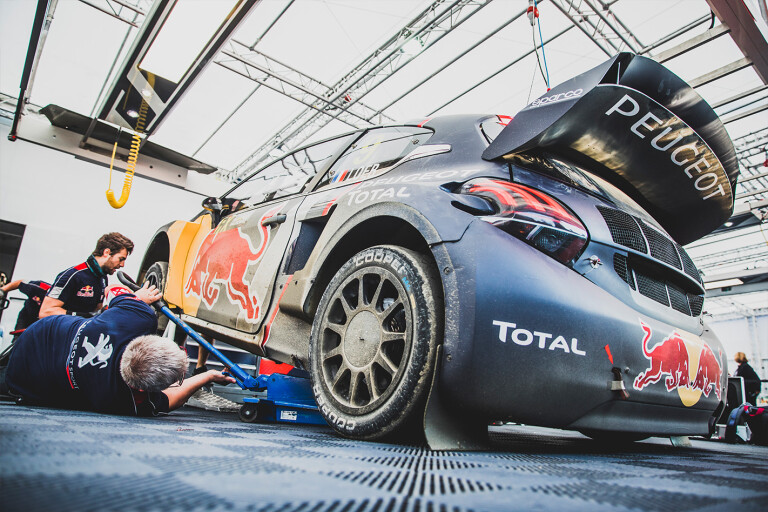
“One thing we do not need is more power.” That's a statement I don't think I've ever heard in any motorsport context before but Nicolas Gueranger, Peugeot Sport's Project Manager for 208 WRX is nothing if not frank.

“The 208 WRX already makes so much power that it is like this in corners,” he says, wide-eyed and frantically flapping at an imaginary steering wheel. “Phew. It's too much.”
The 208 WRX sends 417kW to its four wheels which would give it a power to weight ratio comfortably in excess of that of a Bugatti Veyron. Gueranger won't confirm or deny exact figures, but given the fact that rallying demigod Sebastien Loeb is having trouble taming the 208, we can imagine it's a handful.
Quite how difficult it is to drive soon becomes apparent. “The regulations require a 45mm restrictor on the turbocharger,” says Gueranger.
“Because of that, the car makes peak power quite low, just 6000rpm. So we sit at the line at 7500rpm and when you decelerate for a corner, bam, it's making more power,” he laughs.
Peak torque is a monster 850Nm at just 4500rpm. “No need for revs, just brrm, brrm, brrm,” says Gueranger mimicking shortshifting up through the six-speed sequential box. “It is a very difficult car to drive.”

Loeb’s weekend ride has some intriguing technical details. “Clever drivers like Solberg, they will drive up to the back end of your car and tap you here,” he says, pointing the toe of his boot at the exhaust, “and as soon as your exhaust is damaged, poof, you lose 20, 30 percent power. So we did this.” He swings his boot at the tailpipe and gives it an almighty kick. It swings out of line and then returns to its original position. It's mounted on a tiny damper that was borrowed from a truck so no matter how hard you hoof it, it'll move and then return. Ingenious.
“On tarmac it accelerates to 100km/h in 1.9 seconds,” Gueranger claims. “On dirt, maybe 2.7.”
All the wild rear wing structures are functional, but they're not for downforce. “We create a low pressure are at the back of the car using this plastic wing,” says Gueranger. “The reason for this is to pull hot air out of the car. There is a lot of thermal management here.”
With 300mm of suspension travel to cope with the jumps, the ride quality of the 208 WRX is actually pretty plush. Besides, a bit of pitch and squat aids traction, and traction is at an absolute premium in these cars as the FIA regulations don’t allow for any sort of electronic traction management device.

“So the drivers use the rev limiter as a kind of traction control,” says Gueranger, explaining a brain-bending technique of the drivers leaning on the soft intermittent ignition cut to quell wheelspin.
Unlike prior rallycross cars which have been co-developed with the Hansen team, this one is a full in-house job at Peugeot Sport in Versailles and will campaign both this season and next before it's expected that World Rallycross goes full electric in 2020.
The sprint format of the races and requirement for instant, savage acceleration would suit electric powerplants but a more immediate concern is dethroning Volkswagen's dominant Polo R rival in rallycross’ elite Supercar class.
That’ll be quite the task as Johan Kristofferson has wrapped up the 12-round championship early, winning nine of the first ten races. Meanwhile, Loeb is the best-placed Peugeot contender in fifth place overall, behind the two Volkswagens and pair of Audi S1s.



COMMENTS